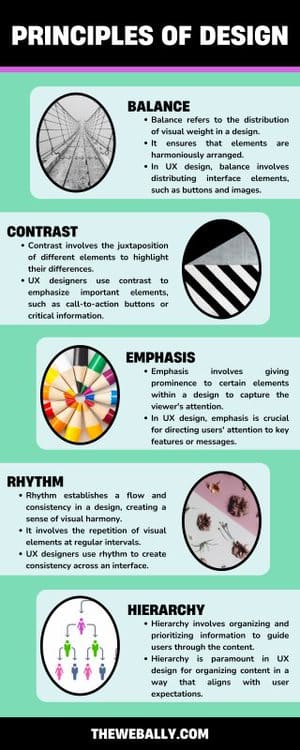Design is a multifaceted discipline that involves a combination of creativity, problem-solving, and aesthetics.
For User Experience (UX) designers, understanding and applying the principles of design is crucial in creating meaningful and effective user interfaces.
In this guide, we will explore the seven fundamental principles of design that serve as the cornerstone for UX professionals.
Here are the main design principles:

Balance refers to the distribution of visual weight in a design. It ensures that elements are harmoniously arranged, creating a sense of stability and equilibrium.
In UX design, balance involves distributing interface elements, such as buttons and images, to create a visually pleasing and user-friendly layout. Achieving balance ensures that users can navigate the interface intuitively without feeling overwhelmed.
Contrast involves the juxtaposition of different elements to highlight their differences. It aids in establishing a visual hierarchy and drawing attention to specific elements.
UX designers use contrast to emphasize important elements, such as call-to-action buttons or critical information. By employing contrasting colors, sizes, or styles, designers guide users’ focus and enhance the overall user experience.
Emphasis involves giving prominence to certain elements within a design to capture the viewer’s attention. It helps convey the hierarchy of information.
In UX design, emphasis is crucial for directing users’ attention to key features or messages. Whether it’s a headline, a critical button, or an error message, emphasis ensures that users engage with the most important aspects of the interface.
Rhythm establishes a flow and consistency in a design, creating a sense of visual harmony. It involves the repetition of visual elements at regular intervals.
UX designers use rhythm to create consistency across an interface. Consistent spacing, typography, and button styles contribute to a seamless and predictable user experience.
Proportion involves the relationship between different elements’ sizes in a design. It ensures that visual elements are appropriately sized relative to each other.
Proportion is essential in UX design for maintaining a balanced and visually appealing interface. Properly proportioned elements contribute to a cohesive and aesthetically pleasing user interface.
Unity refers to the cohesion and coherence of elements in a design. It ensures that all design elements work together harmoniously to convey a unified message.
Achieving unity in UX design involves maintaining a consistent visual language throughout the interface. Consistent colors, fonts, and styling contribute to a unified user experience across different screens and interactions.
Hierarchy involves organizing and prioritizing information to guide users through the content. It establishes a clear structure that helps users understand the relative importance of different elements.
Hierarchy is paramount in UX design for organizing content in a way that aligns with user expectations.
By employing visual cues like size, color, and placement, designers ensure that users can easily navigate and comprehend the interface.
In the world of UX design, understanding and applying the seven principles of design is fundamental to creating interfaces that are not only visually appealing but also intuitive and user-friendly.
By mastering these principles, UX professionals can elevate their designs and deliver exceptional user experiences that resonate with users on both aesthetic and functional levels.
The Web Ally ensures each of these elements in its interface designs, so you can be sure of getting higher user engagement. To discuss your project further, contact our team today!
Self-service covers every aspect of life these days, but we still believe in the power of having someone to talk to. Maybe it's to bounce off ideas and explore new opportunities. Maybe it's just to say hello.
In any case, we will only use your contact details to get in touch with you regarding your enquiry - and nothing else!